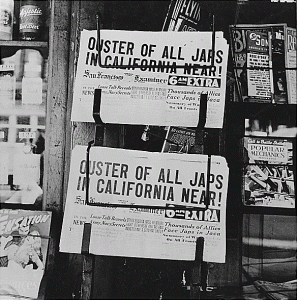On this day in 1942, in response to the Imperial Japanese Army’s attack on Pearl Harbor two months earlier, U.S. President Franklin D. Roosevelt issued Executive Order 9066 which cleared the way for some 120,000 Japanese Americans to be relocated to concentration camps for the duration of World War Two. This segregationist government decree – one of the most serious violations of civil liberties in American history – suspended the writ of habeas corpus and for over three years denied American citizens their rights to life, liberty and property as guaranteed by the Fifth Amendment.
Justifying the order on the grounds of military necessity, Roosevelt declared that Japanese Americans were a threat to national security. But the internment had nothing to do with national security; even the infamously paranoid FBI Director J. Edgar Hoover had just three months earlier concluded that Japanese Americans posed no security threat and indeed there is not one recorded instance of sabotage or espionage by Japanese American citizens or residents before or during the war. Executive Order 9066 was in truth the government’s racist strategy to whip up patriotic pro-war, anti-Japanese hysteria. While it officially included all citizens and residents of America’s three Axis enemies, both German and Italian American suspects were granted individual hearings. But Japanese Americans were regarded wholesale as an enemy race. The order indiscriminately applied to “all persons” of Japanese ancestry regardless of age, sex or citizenship – even orphaned babies with just a fraction of Japanese blood were not exempt. And for the West Coast with its long tradition of anti-Japanese sentiment, the war was a welcome excuse to rid itself of what it deemed the scourge of immigrants. Roosevelt’s own racist roots can be traced back to 1925 when he wrote: “Californians have properly objected on the sound basic grounds that Japanese immigrants are not capable of assimilation into the American population… Anyone who has travelled in the Far East knows that the mingling of Asiatic blood with European and American blood produces, in nine cases out of ten, the most unfortunate results.”
Two months after Executive Order 9066 was issued, the “relocation” process of Japanese Americans from the entire West Coast began. Public notices were posted announcing that all Japanese Americans – even those with as little as 1/16th Japanese blood – had 48 hours to sell their property and possessions and gather at assembly points. Farmers and business owners, forced to sell their interests far below market value, suffered financial losses estimated in the billions of dollars. Each family was issued a number, instructed to bring only what they could carry and then herded onto crowded trains to be transported to “concentration camps” – as FDR himself referred to them. All ten camps were in remote, desolate areas; some were hastily assembled on Native American reservations, without prior agreement or consultation. Surrounded by fences with barbed wire, armed guards were stationed in watchtowers with orders to shoot to kill anyone who attempted to escape. Most of the able-bodied internees were used as a sweatshop labour force for the U.S. military, while many of the young men – deemed such ‘threats’ to national security – were astoundingly still subject to the draft. Sixty-three second-generation Japanese American men interned in Heart Mountain, Wyoming resisted – insisting that they would not serve until their rights as U.S. citizens were restored. They were tried for draft evasion in the largest mass trial in Wyoming’s history, and each sentenced to three years in prison. There were further attempts to challenge EO 9066; a few cases even reached the Supreme Court. In 1966, Tom Clark – the Associate Justice of the Supreme Court – would confess: “I have made a lot of mistakes in my life. One is my part in the evacuation of the Japanese from California in 1942… I don’t think that served any purpose at all. We picked them up and put them in concentration camps. That’s the truth of the matter. And as I look back on it – although at the time I argued the case – I am amazed that the Supreme Court ever approved it.”
Thirty-four years after the signing of Executive Order 9066, President Gerald Ford admitted that the evacuation and internment of Japanese Americans had been “wrong.” Surviving victims were offered $20,000 in reparation for the loss of their civil liberties and property. Following this paltry gesture, the unsavoury matter was once again swept under the carpet. But with US nationalism never more rampant, America would do well to remember this cautionary tale from the annals of its own history. Despite the virtuous and supposedly fail-safe laws of the Constitution, the American government illegitimately targeted a race of people for removal from the general public. And the rest of the society let it happen. Does that not sound eerily familiar?



4 Responses to 19th February 1942 – Roosevelt Issues Executive Order 9066